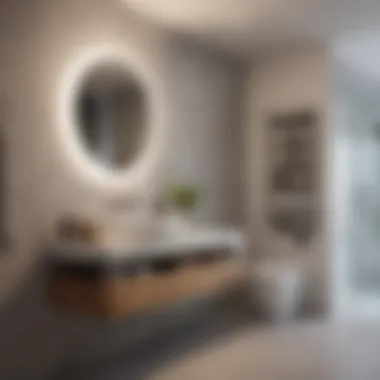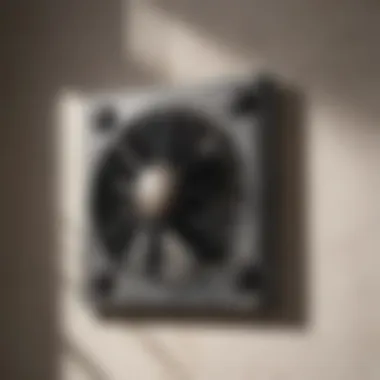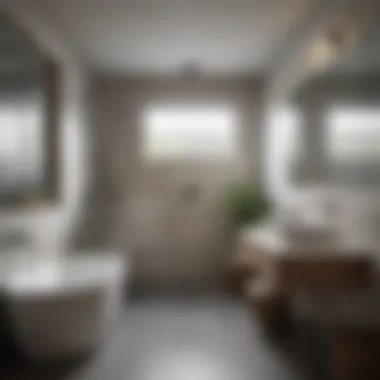Step-by-Step Guide: Adding a Bathroom Exhaust Fan for Improved Ventilation


Materials:
- Exhaust fan unit
- Vent cap
- Ductwork
- Roof vent
- Flexible duct connector
- Vent hose clamp
- Electric drill
- Screwdriver
- Hacksaw
- Measuring tape
- Safety gloves
- Safety goggles
- Screws
DIY Steps:
To start adding a bathroom exhaust fan, first, ensure you have all the necessary materials in front of you. Measure the area where you will install the exhaust fan to determine the right size for the vent and fan unit. Cut a hole in the desired spot on the bathroom ceiling for the fan unit.
Next, prepare the ductwork by connecting the flexible duct connector to the fan unit and securing it with a vent hose clamp. Install the ductwork that will lead to the roof vent. Make sure it is properly sealed to prevent air leaks.
Finally, attach the vent cap on the roof to allow the air from the exhaust fan to escape outside. Use screws to secure it in place and ensure a tight fit to prevent water leakage. Test the fan to confirm airflow and functionality.
Technical Aspects:
The tools required for this project include an electric drill, screwdriver, hacksaw, and measuring tape. Safety gloves and goggles are essential for protection. The installation process may take a few hours to complete, depending on your expertise and the complexity of the project.
Precise measurements are crucial to ensure a proper fit for the exhaust fan and vent cap. Pay attention to securing all connections tightly to avoid any potential leaks. It is recommended to follow the manufacturer's instructions for the specific model of the exhaust fan.
DIY Project Process:
The sequential steps for installing a bathroom exhaust fan involve meticulous planning and precise execution. Start by marking the installation spot accurately on the ceiling. Cut the hole carefully to fit the fan unit snugly. Connect the ductwork and route it towards the roof, ensuring a smooth airflow path.


Troubleshooting Tips: If you encounter issues during the installation, such as improper airflow or noise from the fan, check for any obstructions in the ductwork or fan unit. Make sure all connections are secure and sealed correctly to prevent air leaks. Adjust the fan settings if needed to optimize performance and ventilation in your bathroom.
Preamble
Bathroom ventilation is a crucial aspect when it comes to maintaining a healthy and comfortable indoor environment. The installation of a bathroom exhaust fan plays a pivotal role in keeping moisture and odors at bay, preventing mold and mildew growth, and promoting better air quality. This comprehensive guide will walk you through the step-by-step process of adding a bathroom exhaust fan to enhance the ventilation in your bathroom effectively. From understanding the benefits of proper ventilation to the intricate installation process, this guide covers all the necessary aspects to help you transform your bathroom into a more pleasant and hygienic space.
Why Install a Bathroom Exhaust Fan?
Efficient ventilation is essential in a bathroom to mitigate the buildup of excess moisture, which can lead to mold growth and structural damage over time. A bathroom exhaust fan helps in expelling humid air, preventing moisture-related issues, and facilitating quicker drying of surfaces post-showering. By improving air circulation, the exhaust fan also aids in maintaining a fresh and odor-free ambiance in the bathroom. Additionally, proper ventilation can contribute to extending the lifespan of fixtures and fittings by reducing the impact of moisture-related deterioration.
Types of Bathroom Exhaust Fans
There are various types of bathroom exhaust fans available on the market to cater to different ventilation needs. Ceiling-mounted fans are a popular choice, discreetly integrated into the ceiling for efficient air extraction. Wall-mounted fans offer flexibility in installation and are suitable for bathrooms where ceiling installation may not be feasible. Inline fans are ideal for situations where long duct runs are necessary, allowing for quiet operation while maintaining powerful ventilation. Finally, combination units with features such as lights and heaters provide added functionality along with ventilation, enhancing the overall utility of the exhaust fan system.
Planning and Preparation
When embarking on the journey of adding a bathroom exhaust fan, thorough planning and meticulous preparation are crucial to ensure a successful outcome. The planning phase sets the foundation for the entire project, dictating key decisions and actions to follow. By allocating sufficient time to assess the specific ventilation needs of your bathroom and selecting the appropriate exhaust fan, you pave the way for an efficient and effective installation process.
Effective planning entails evaluating various factors such as the bathroom's size, usage patterns, existing ventilation system, and moisture levels. Understanding these key elements allows you to determine the optimal airflow requirements and placement of the exhaust fan for maximum effectiveness. Additionally, considering noise levels, energy efficiency, and aesthetic preferences during the planning stage ensures a well-rounded approach to enhancing your bathroom's ventilation.
Preparation is equally paramount, ensuring that you have all the necessary tools and materials at hand before initiating the installation. This includes exhaust fan unit, ducting, electrical wiring components, screws, and any additional accessories required. Adequate preparation also involves clearing the installation area, ensuring accessibility and safety throughout the process. By taking the time to plan meticulously and prepare thoroughly, you set the stage for a seamless and hassle-free installation experience.
Assessing Ventilation Needs


Assessing your bathroom's ventilation needs is a critical first step in adding an exhaust fan. Start by examining the current ventilation system, if any, and identifying areas for improvement. Consider factors such as humidity levels, condensation buildup, and air quality to determine the adequacy of existing ventilation.
Calculate the air exchange rate required for your bathroom based on its size and usage. Typically, bathrooms require a certain number of air changes per hour to maintain optimal air quality and moisture levels. This calculation helps you select an exhaust fan with the appropriate airflow capacity to effectively ventilate the space.
Furthermore, assess the placement of the exhaust fan to ensure optimal airflow distribution. Consider centrally locating the fan to better capture steam and odors, maximizing its overall performance. Taking the time to assess your bathroom's ventilation needs comprehensively sets the stage for selecting the most suitable exhaust fan to address your specific requirements.
Selecting the Right Exhaust Fan
Choosing the right exhaust fan is a crucial decision that directly impacts the effectiveness of your bathroom ventilation system. Consider factors such as the fan's airflow capacity, noise level, energy efficiency, and ducting requirements when making your selection.
Opt for an exhaust fan with a sufficient airflow capacity to adequately ventilate your bathroom based on its size and usage. A fan with adjustable speed settings allows you to customize ventilation levels according to the need, enhancing flexibility and energy conservation. Additionally, select a fan with low noise levels to maintain a peaceful bathroom environment during operation.
Energy efficiency is another key consideration, as it not only reduces utility costs but also minimizes environmental impact. Look for exhaust fans with high Energy Star ratings, indicating superior energy efficiency and performance. Lastly, ensure compatibility with the existing ductwork in your bathroom to streamline the installation process.
By meticulously evaluating these factors and selecting the right exhaust fan based on your specific needs, you can optimize ventilation, enhance air quality, and create a more comfortable and pleasant bathroom environment.
Installation Process
In this segment, we delve into the crucial phase of the bathroom exhaust fan addition - the Installation Process. This pivotal step ensures that your ventilation system functions optimally, keeping your bathroom fresh and humidity-free. Proper installation is paramount to avoid issues down the line and to reap the full benefits of your exhaust fan. From gathering the necessary tools and materials to connecting the electrical wiring, each sub-section plays a vital role in the successful installation of your exhaust fan.
Gathering Necessary Tools and Materials


Before commencing the installation, it is imperative to gather all the essential tools and materials. You will require a screwdriver, wire cutters, electrical tape, circuit tester, saw, drill, screws, and the exhaust fan unit itself. Ensuring you have all the necessary items at hand will simplify the installation process and prevent delays. Select high-quality tools and materials to guarantee a sturdy and long-lasting installation.
Preparing the Installation Area
Preparing the installation area is a critical step in the process. Clear the work area of any obstructions and ensure there is ample space to maneuver during installation. Identify the optimal location for your exhaust fan, typically near the shower or bath, to maximize its efficiency. Prepare the ceiling or wall surface appropriately, ensuring it is clean and free of any obstacles that could impede the installation.
Installing the Exhaust Fan Unit
The installation of the exhaust fan unit involves mounting it securely to the ceiling or wall as per the manufacturer's instructions. Use the appropriate hardware and tools to affix the unit in place. Ensure it is level to guarantee proper operation and a seamless finish. Follow the provided guidelines meticulously to avoid errors and to ensure optimal performance of your exhaust fan.
Connecting Electrical Wiring
Connecting the electrical wiring is a crucial step that requires precision and caution. Follow the wiring diagram provided with the exhaust fan unit to connect the wires correctly. Use wire connectors to secure the connections and prevent any electrical mishaps. Double-check the wiring to ensure it is correct before proceeding to the next step.
Testing and Troubleshooting
Once the installation and wiring are complete, it is time to test the exhaust fan. Turn on the fan to verify that it is operating smoothly and effectively. Listen for any unusual noises or vibrations that could indicate a problem. If issues arise, troubleshoot them promptly to rectify any faults and ensure your exhaust fan is functioning as intended.
Additional Considerations
When it comes to adding a bathroom exhaust fan, there are key additional considerations that must not be overlooked. These factors play a crucial role in ensuring the optimal functioning and longevity of your exhaust fan system. Upkeep and maintenance are essential aspects to keep your bathroom exhaust fan in top working condition. Regular cleaning of the fan blades, housing, and ductwork is vital to prevent obstructions and maintain efficient airflow. Additionally, checking and replacing filters as needed will help enhance the fan's performance. Periodic inspection of the motor and wiring is also recommended to avoid potential malfunctions.
Upkeep and Maintenance
Maintaining your bathroom exhaust fan is paramount for its effectiveness and longevity. Proper upkeep ensures that the fan operates at its best, providing adequate ventilation in your bathroom. Regular cleaning of the exhaust fan components is a fundamental maintenance task. Dust and debris can accumulate over time, hindering the fan's efficiency. By cleaning the fan blades, housing, and ductwork, you can promote optimal airflow and prevent blockages. It is also essential to inspect and replace filters regularly. Clogged filters can impede air circulation and strain the fan motor. Additionally, checking for any signs of wear and tear, such as frayed wiring or motor issues, is crucial for preventing potential malfunctions. By adhering to a simple maintenance routine, you can extend the lifespan of your bathroom exhaust fan and enjoy consistently improved ventilation.
Enhancing Energy Efficiency
Incorporating energy-efficient practices when adding a bathroom exhaust fan can lead to long-term savings and environmental benefits. Selecting an exhaust fan with a high energy efficiency rating is a prudent choice. These models are designed to operate optimally while consuming minimal energy. Timer or humidity sensor-controlled exhaust fans are effective in reducing energy consumption by activating only when needed. Proper installation of the exhaust fan is also crucial for energy efficiency. Ensuring a tight seal between the fan, ductwork, and exterior vent prevents air leakage, maximizing the fan's effectiveness. Additionally, insulating ductwork in unconditioned spaces helps maintain airflow temperature, increasing overall energy efficiency. By implementing these strategies, you can not only improve the ventilation quality in your bathroom but also reduce energy costs and minimize environmental impact.







